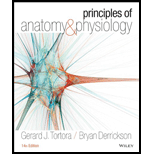
Principles of Anatomy and Physiology
14th Edition
ISBN: 9781118345009
Author: Gerard J. Tortora
Publisher: WILEY
expand_more
expand_more
format_list_bulleted
Question
Chapter 20, Problem 16CP
Summary Introduction
To review:
Whether the amount of blood flowing through the coronary artery during ventricular diastole or ventricular systole is more or less.
Introduction:
Apart from the pulmonary and systemic circular, coronary circulation also takes place, which supplies blood to different regions of heart. The vessels that supply blood to the myocardium are a part of the coronary circulation. The oxygenated blood from the aorta in the left atrium is picked up by two coronary arteries, each entering into the left and right atrium.
Expert Solution & Answer
Want to see the full answer?
Check out a sample textbook solution
Students have asked these similar questions
Explain in a small summary how:
What genetic information can be obtained from a Punnet square? What genetic information cannot be determined from a Punnet square?
Why might a Punnet Square be beneficial to understanding genetics/inheritance?
In a small summary write down:
Not part of a graded assignment, from a past midterm
Chapter 20 Solutions
Principles of Anatomy and Physiology
Ch. 20 - l. Define each of the following external features...Ch. 20 - 2. Describe the structure of the pericardium and...Ch. 20 - 3. What are the characteristic internal features...Ch. 20 - Prob. 4CPCh. 20 - 5. What is the relationship between wall thickness...Ch. 20 - Prob. 6CPCh. 20 - What causes the heart valves to open and to close?...Ch. 20 - In correct sequence, which heart chambers, heart...Ch. 20 - Prob. 9CPCh. 20 - Prob. 10CP
Ch. 20 - 11. In what ways are autorhythmic fibers similar...Ch. 20 - What happens during each of the three phases of an...Ch. 20 - 13. In what ways are ECGs helpful in diagnosing...Ch. 20 - How does each ECG wave, interval, and segment...Ch. 20 - 15. Why must left ventricular pressure be greater...Ch. 20 - Prob. 16CPCh. 20 - During which two periods of the cardiac cycle do...Ch. 20 - Prob. 18CPCh. 20 - Prob. 19CPCh. 20 - Prob. 20CPCh. 20 - Prob. 21CPCh. 20 - Define cardiac reserve. How does it change with...Ch. 20 - Prob. 23CPCh. 20 - 24. What are some of the cardiovascular benefits...Ch. 20 - Prob. 25CPCh. 20 - Prob. 26CPCh. 20 - Why is the cardiovascular system one of the first...Ch. 20 - From which tissue does the heart develop?
Knowledge Booster
Learn more about
Need a deep-dive on the concept behind this application? Look no further. Learn more about this topic, biology and related others by exploring similar questions and additional content below.Similar questions
- Noggin mutation: The mouse, one of the phenotypic consequences of Noggin mutationis mispatterning of the spinal cord, in the posterior region of the mouse embryo, suchthat in the hindlimb region the more ventral fates are lost, and the dorsal Pax3 domain isexpanded. (this experiment is not in the lectures).a. Hypothesis for why: What would be your hypothesis for why the ventral fatesare lost and dorsal fates expanded? Include in your answer the words notochord,BMP, SHH and either (or both of) surface ectoderm or lateral plate mesodermarrow_forwardNot part of a graded assignment, from a past midtermarrow_forwardNot part of a graded assignment, from a past midtermarrow_forward
- please helparrow_forwardWhat does the heavy dark line along collecting duct tell us about water reabsorption in this individual at this time? What does the heavy dark line along collecting duct tell us about ADH secretion in this individual at this time?arrow_forwardBiology grade 10 study guidearrow_forward
arrow_back_ios
SEE MORE QUESTIONS
arrow_forward_ios
Recommended textbooks for you
 Human Physiology: From Cells to Systems (MindTap ...BiologyISBN:9781285866932Author:Lauralee SherwoodPublisher:Cengage Learning
Human Physiology: From Cells to Systems (MindTap ...BiologyISBN:9781285866932Author:Lauralee SherwoodPublisher:Cengage Learning Fundamentals of Sectional Anatomy: An Imaging App...BiologyISBN:9781133960867Author:Denise L. LazoPublisher:Cengage Learning
Fundamentals of Sectional Anatomy: An Imaging App...BiologyISBN:9781133960867Author:Denise L. LazoPublisher:Cengage Learning Medical Terminology for Health Professions, Spira...Health & NutritionISBN:9781305634350Author:Ann Ehrlich, Carol L. Schroeder, Laura Ehrlich, Katrina A. SchroederPublisher:Cengage Learning
Medical Terminology for Health Professions, Spira...Health & NutritionISBN:9781305634350Author:Ann Ehrlich, Carol L. Schroeder, Laura Ehrlich, Katrina A. SchroederPublisher:Cengage Learning

Human Physiology: From Cells to Systems (MindTap ...
Biology
ISBN:9781285866932
Author:Lauralee Sherwood
Publisher:Cengage Learning

Fundamentals of Sectional Anatomy: An Imaging App...
Biology
ISBN:9781133960867
Author:Denise L. Lazo
Publisher:Cengage Learning



Medical Terminology for Health Professions, Spira...
Health & Nutrition
ISBN:9781305634350
Author:Ann Ehrlich, Carol L. Schroeder, Laura Ehrlich, Katrina A. Schroeder
Publisher:Cengage Learning

The Cardiovascular System: An Overview; Author: Strong Medicine;https://www.youtube.com/watch?v=Wu18mpI_62s;License: Standard youtube license